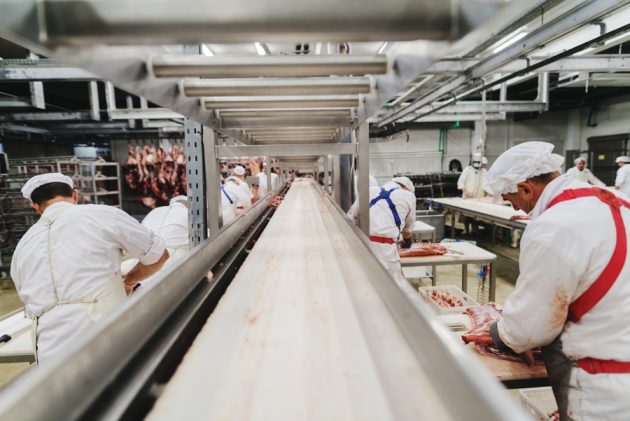
The hidden threat
By Treena Hein
Business Operations Meat &Poultry Cybersecurity Editor pick meat processingStrategies for improving cybersecurity in meat processing facilities
 Photo © Dusanpetkovic1 / Adobe Stock
Photo © Dusanpetkovic1 / Adobe Stock In early June 2021, the US arm of JBS announced it had paid the equivalent of $11 million to address a ransomware attack. Ransomware is malicious software, which blocks access to a victim’s IT system or encrypts important data in the system, holding it ransom until demands are met. In short, a company or institution is paralyzed until it releases the required funds.
In a press release, JBS USA CEO Andre Nogueira said, “This was a very difficult decision to make for our company and for me personally. However, we felt this decision had to be made to prevent any potential risk for our customers.”
JBS also said it spends more than USD200 million annually on IT and employs more than 850 IT professionals globally to manage and protect its data.
As is the case when anything negative hits close to home, this attack has forced North American food companies to take stock of their IT infrastructure.
“Cybersecurity is something that certainly caught our industry’s and the whole business community’s attention,” says Jean-Michel Laurin, president and CEO at Canadian Poultry and Egg Processors Council. “I know the government – more specifically Public Safety Canada and Communications Security Establishment – have been leading a public awareness campaign focused on businesses, their employees and third-party services providers that support our members. As for our association, our involvement has been focused on sharing information and intelligence with members.”
Food and Beverage Canada CEO Kathleen Sullivan notes that although her organization currently has no cybersecurity working group, the issue is a top concern for Canada’s 8,000 food and beverage manufacturers. Every company must have both attack prevention and contingency plans in place, she says. Sullivan also recommends mock events as useful training and exploration exercises in order to prepare for cyberattacks or other emergencies.
“Even if the real crisis is not exactly what you’ve practiced,” Sullivan explains, “you are still more prepared.”

Food processors must perform an in-depth threat analysis and create a detailed strategy to minimize cyber threats. Photo © Gorodenkoff / Adobe Stock
Expert perspectives
To get further insight and guidance on cybersecurity at this point in time, Food in Canada reached out to some world-renowned experts such as Dr. Apala Ray, ABB’s global cybersecurity manager, process industries division.
Ray notes cyberattacks can be generic or more targeted, but in both cases, they are very serious.
“In food and beverage, cyberattacks could jeopardize the supply chain from suppliers to manufacturers,” she explains. “Shipments from manufacturers to customers could be affected, and in the worst case, a cyberattack could affect the industrial control system (ICS) and even affect food product safety and integrity.”
Even if the attack does not directly target ICS and automation systems, it can paralyze operations, costing billions in lost business and cleanup activities.
Indeed, according to Paul Griswold, chief product officer of Honeywell’s Connected Cybersecurity business, cyber attackers will continue to increase their focus on industrial and manufacturing targets due to the potential of large ransom payouts.
“The shutdown of a plant is very quantifiable in terms of dollars of revenue lost per hour,” he says, “and high ransom amounts are being set accordingly.”
The problem posed by ransomware and other types of cyberattacks is acute for operational technology (OT) systems employed in manufacturing, Griswold explains, because many of these systems run on old and outdated hardware and software. Compounding the problem are the concerns from company leadership about security monitoring affecting the production process.
However, Griswold says that “in reality, OT systems can be effectively monitored from a cybersecurity perspective. But companies must implement solutions that are specifically built for this purpose.”
Solutions
The first thing companies must do, says Mike Lester, director of cybersecurity strategy, governance and architecture at Emerson, is to perform a thorough threat analysis using industry-proven references.
“Like other manufacturers, food processors must align their different systems—from operations, manufacturing systems and enterprise systems to IT security and plant cybersecurity—around business continuity and resiliency objectives,” he says. “Together, these groups should perform a thorough threat analysis and from there, develop an in-depth strategy to mitigate those threats and operational risks.”
Food product makers should also specifically consider the degree of independence of their control and safety functions in processing lines, and where there is opportunity to apply network segmentation or isolation. Additionally, companies should examine aspects like where connections to access operational or monitoring data are needed, and whether ‘legacy systems’ have been isolated for protection if they are not capable of more advanced security functions.
Ray adds that everyone working at the firm needs to follow fundamental security practices in their daily work when creating and storing passwords, working outside the office, and storing and sharing data and information.
As with any difficult scenario such as the recent JBS attack, there are silver linings to be had, even if they are restricted to an increase in sector awareness.
In Griswold’s words, “due to recent attacks, many industrial/manufacturing companies are beginning to greatly increase their attention on OT security, which is very positive.” Hopefully attention will turn to action before another attack occurs.

A breakfast charcuterie. Photo courtesy Egg Farmers of Canada
Canadian meat and egg product trends
The Canadian meat and egg sector, like all the others, has taken notice of how the pandemic has changed consumer trends and has therefore adjusted its product offerings and marketing campaigns.
For example, the pandemic increased home cooking, and ‘cooking fatigue’ set in quite quickly, motivating consumers to seek out new flavours.
Accordingly, “Canadian retail and foodservice operators can leverage inspiration from global markets of Canadian pork for new and innovative merchandising options, cooking methods and flavours,” explains Kevin Mosser, Canada Pork International’s marketing director.
For example, they can access Canada Pork’s new ‘Sizzling Stir Fry’ program, which includes new product options and point-of-sale support materials for retail and foodservice operators. Canada Pork also offers other product ideas, pork merchandising and marketing support and other resources on its websites.
Eggs also fit perfectly with the current consumer trend of exploring global flavours. Eggs are a staple part of many cuisines worldwide, “from colourful bibimbap topped with a fried egg to egg biryani,” explains Kim Kessler, nutrition manager at Egg Farmers of Canada.
She pinpoints the trend of breakfast charcuterie, a collection of foods displayed on a large serving board. Grocers can create their own brunch boards, she says, complete with mini quiches or hard-boiled eggs.
Inspiration is also central to marketing beef in Canada right now. Canada Beef president Michael Young reports a 167 per cent increase in searches on its website for ideas and inspiration since the start of the pandemic. Since there’s a resurgence in QR code use since COVID began, Canada Beef is now launching a digital consumer information portal called ‘BIG’ (Beef Information Gateway), accessible via a QR code or the barcode on each beef product package.
“We believe that customer experience is key and the BIG solution will be a game changer for the beef sector,” says Young. “Our goal is to simplify selection, preparation and enjoyment of a wider variety of beef cuts, and we plan to invest with retail clients to bring the gateway to consumers. We also have long-term plans to use the gateway to introduce new cuts, new preparation methods and receipts to serve a wider scope of consumers across Canada and the export marketplace.”
Uncertainty has also driven up demand for comfort foods. These include eggs along with (for some consumers) certain meat products such as chicken sandwiches from fast food restaurants. This is evidenced, says Canadian Poultry and Egg Processors Council CEO Jean-Michel Laurin, by the chicken sandwich ‘wars’ that heated up in 2020 among major fast food restaurants.
The pandemic has also boosted interest in local foods. Laurin reports customers of his association members are doing more to emphasize “they are sourcing products raised by Canadian farmers and processed in Canada.”
Local food interest, he says, is a matter of having greater trust in the health and safety of local products, but also a desire among Canadians to support local jobs and businesses.
This article was originally published in the February/March 2022 issue of Food in Canada.
Print this page